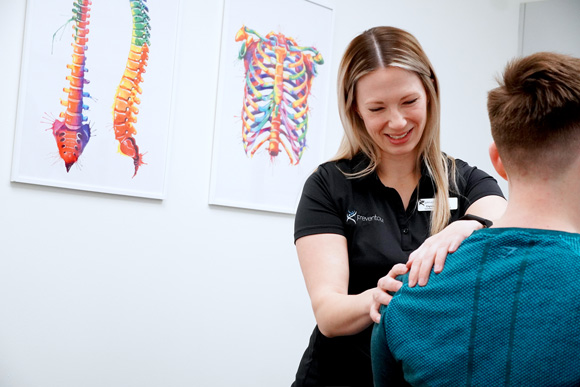We’ve all had an injury at one time or another, be it a rolled ankle or a strained muscle. But have you ever wondered what’s going on in your body to heal the injury, or how exactly rehabilitation affects tissue healing? Allow me to walk you through the process and show you how rehabilitation can assist with injury healing.
Injuries can be broadly classified by two types of forces: macrotraumatic forces or microtraumatic forces. Macrotraumatic forces result in trauma-type, acute injuries, such as fractures, dislocations, sprains and strains. These types of injuries result from an accident or trauma. Microtraumatic forces results in chronic, overuse injuries, such as tendinitis and bursitis. These types of injuries often result from repetitive loading or incorrect mechanics. If you are injured at a sporting event your team’s Athletic Therapist’s main goal is to manage the primary injury (the one that just occurred) to reduce secondary injury. Secondary injury is further damage to the tissues caused by the inflammatory response. After the initial injury, the healing process can be divided into three phases:
Inflammatory Response Phase: This phase starts immediately after the injury occurs and lasts up to 4 days. Injury to the cells result in altered cellular metabolism, resulting in the redness, swelling, tenderness and heat that we often see right after an injury. The initial inflammation delivers leukocytes and phagocytic cells to the injured tissue to remove the waste and set the stage for healing. This inflammation is a protective mechanism, whereby our body can dispose of by-products from injury. Rehabilitation at this stage focuses on controlling swelling and managing pain. It is true that some inflammation is good, even necessary, but too much swelling increases pressure on the injured area and increases pain. Too much swelling also causes neuromuscular inhibition (weakens our muscles) and slows the healing process from progressing to the next stage. If the acute inflammatory process does not respond sufficiently, chronic inflammation can result. Early mobility exercises can help the natural healing process and prevent chronic inflammation.
Fibroblastic Repair Phase: This is the second phase of the healing process. This phase begins once the swelling has reduced and can last for as long as 4-6 weeks. Scar formation and repair of injured tissue are the focus of this phase. Oxygen delivery and blood flow to the injured area increase, resulting in the delivery of nutrients for regeneration. An extracellular matrix made of collagen and elastin begin to form to increase the strength of the wound. Rehabilitation at this phase focuses on assisting the tissues with the healing through modalities and exercises. Laser therapy, for example, helps to increase blood flow and circulation to the area, as well as speed up cellular regeneration and collagen production. By use of manual therapy techniques and exercises, we also aim to restore range of motion and re-establish neuromuscular control at this phase. It is important that we assist the central nervous system relearn to integrate visual, proprioceptive and kinematic information at this stage so we are able to produce coordinated movement and start to return to near-normal function.
Maturation Remodeling Phase: The final phase of healing. This is a long-term process that may take several years to totally complete. This phase focuses on the realignment of collagen fibres as well as processes that continue to increase the strength of the scar on the wound. The realignment of the scar matrix fibres is important for mobility and force production. Rehabilitation assists with this realignment of fibres through a more aggressive range of motion and strengthening exercises. The right amount of stress to body tissues helps them to heal more effectively. At this stage, we also focus on functional exercises and sport-specific progressions. It is important to return to activity at appropriate levels to prevent a recurring or a new injury. Prevention is always a part of rehabilitation. The Maturation Remodeling Phase is also the time to incorporate plyometric exercises that work on power and explosiveness.
Crystal Bartkowski
Athletic Therapy

